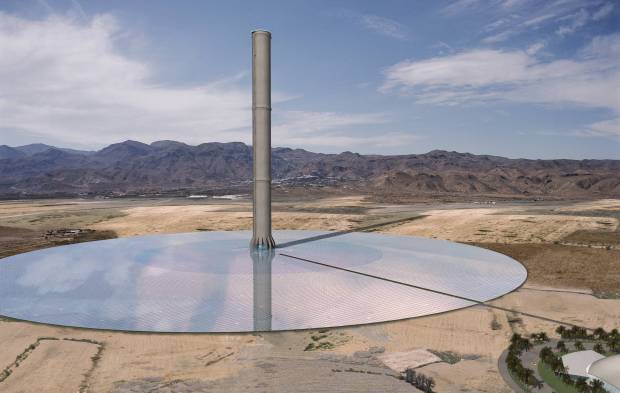There are many different ways that you can extract usable energy from sunlight, and they all have their advantages and disadvantages. Historically, the biggest disadvantage has been cost when compared to more traditional sources of energy, such as coal-fired power plants. For if solar power was an economical and practical alternative to other forms of energy generation today, it would already be deployed on a wide scale.
I think it is only a matter of time before renewable energy sources become more cost competitive. The question is which methods make the most sense. My favorite idea is the ‘Solar Tower’ (or ‘solar updraft tower’, or ‘solar chimney’), an artists rendering of which is shown below.
While most people have never heard about it, the Solar Tower design was implemented on a small scale in Spain years ago to test the concept. More recently, a privately-funded company called EnviroMission has been working toward the construction of one or more 200 megawatt power plants in the Australian Outback. The company has also been actively pursuing plans to build power plants in China and Nevada.
The design appeals to me because it harnesses the weather, albeit on a small scale. Specifically, it collects the daily production of warm air that forms near the ground, and funnels all of that warm air into a chimney where turbines are located to extract energy from the rising air. It’s a little like wind tower technology, but rather than just extracting energy from whatever horizontally-flowing wind happens to be passing by, the Solar Tower concentrates all of that warm air heated by the ground into the central tower, or chimney, where the air naturally rises. Even on a day with no wind, the solar tower will be generating electricity while conventional wind towers are sitting there motionless.
The total amount of energy that can be generated by a Solar Tower depends upon two main factors: (1) how much land area is covered by the clear canopy, and (2) the total height of the tower. EnviroMission’s baseline design has included a glass canopy covering up to several square miles of desert land, and a tower 1,000 meters tall. Such a tower would be the tallest manmade structure of any kind in the world, although more recently EnviroMission has been talking about several smaller-scale power plants as a more cost-effective approach. Since the design is proprietary, details have remained secret.
Since the Solar Tower is based upon physical processes that people like me deal with routinely in our research, I can immediately see ways in which the efficiency of the design can be maximized. For instance, a third major factor that also determines how much energy would be generated is the temperature difference between the power plant’s surroundings and the air underneath the canopy. After all, it is that temperature difference which provides the energy source, since warm air is less dense than cool air, and so ‘wants’ to rise.
This means that you could increase the power plant’s output by building it where the sand is quite reflective (bright), and then covering the ground under the canopy area with black rock — say crushed lava rock — which would then get the hottest when the sun shines on it.
One of the advantages of a Solar Tower over using photovoltaic cells to generate electricity is that the Solar Tower keeps generating electricity even after the sun goes down. Because the ground under the canopy stays warm at night, it continues to warm the air while the land around the canopy cools much more rapidly. This maintains a temperature difference between the canopy-covered air and the plant’s surroundings, which translates into continued energy generation at night. Additionally, the Solar Tower does not require the huge volume of water that coal-fired plants use.
From what I’ve read, the Solar Tower is potentially cost-competitive with coal-fired power plants, but the investment in infrastructure is large, and there is still some uncertainty (and therefore investment risk) involved in just how efficient Solar Towers would be.
If the government insists on providing subsidies for renewable energy, I think Solar Towers might be one of the best investments of the public’s money. But the last I knew, the U.S. Department of Energy was not actively pursuing the Solar Tower technology. I have no idea whether government involvement would help or hurt the private efforts of EnviroMission. Ultimately, the technology needs to be sustainable from a cost standpoint, and when that point is reached it is best if the government stays out of the way.
But just from a political standpoint, I think the Obama administration would benefit by pursuing Solar Towers as a national goal to reduce our dependence on foreign energy. If electricity in the sunnier parts of the country was cheap enough, then plug-in hybrid cars would become more popular there as well, which would reduce our dependence on foreign oil.
A very cool computer-generated video tour of an EnviroMission Solar Tower design can be viewed here (be sure to turn the sound up!). As the video shows, a Solar Tower 1,000 meters tall would also provide quite a tourist attraction.

 Home/Blog
Home/Blog




